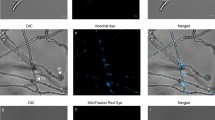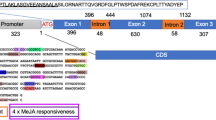Abstract
Although chitin is a major component of the fungal cell wall, in oomycetes (fungal-like organisms), this compound has only been found in very little amounts, mostly in the cell wall of members of the genera Achlya and Saprolegnia. In the oomycetes Phytophthora infestans and P. sojae the presence of chitin has not been demonstrated; however, the gene putatively encoding chitin synthase (CHS), the enzyme that synthesizes chitin, is present in their genomes. The evolutionary significance of the CHS gene in P. infestans and P. sojae genomes is not fully understood and, therefore, further studies are warranted. We have cloned and characterized the putative CHS genes from two Phytophthora spp. and multiple isolates of P. infestans and P. sojae and analyzed their phylogenetic relationships. We also conducted CHS inhibition assays and measured CHS transcriptional activity in Phytophthora spp. during infection of susceptible plants. Results of our investigations suggest that CHS contains all the motifs that are typical in CHS genes of fungal origin and is expressed, at least at the mRNA level, during in vitro and in planta growth. In infected tissues, the highest levels of expression occurred in the first 12 h post inoculation. In addition, results from our inhibition experiments appear to suggest that CHS activity is important for P. infestans normal vegetative growth. Because of the considerable variation in expression during infection when compared to basal expression observed in in vitro cultures of non-sporulating mycelium, we hypothesize that CHS may have a meaningful role in Phytophthora pathogenicity.






Similar content being viewed by others
References
Alexopoulos CJ, Mims CW, Blackwell M (1996) Introductory Mycology. 4th edn. Wiley, New York
Avrova AO, Venter E, Birch PR, Whisson SC (2003) Profiling and quantifying differential gene transcription in Phytophthora infestans prior to and during the early stages of potato infection. Fungal Genet Biol 40:4–14
Badreddine I et al (2008) Cell wall chitosaccharides are essential components and exposed patterns of the phytopathogenic oomycete Aphanomyces euteiches. Eukaryot Cell 7:1980–1993. doi:10.1128/EC.00091-08
Bartnicki-Garcia S (1966) Chemistry of hyphal walls of Phytophthora. Microbiology 42:57–69
Bartnicki-Garcia S, Wang MC (1983) Biochemical aspects of morphogenesis in Phytophthora. In: Erwin DC, Bartnicki-Garcia S, Tsao PH (eds) Phytophthora: its biology, taxonomy, ecology, and pathology. American Phytopatholological Society, St. Paul, pp 121–137
Blair JE, Coffey MD, Park S-Y, Geiser DM, Kang S (2008) A multi-locus phylogeny for Phytophthora utilizing markers derived from complete genome sequences. Fungal Genet Biol 45:266–277
Bowen AR, Chen-Wu JL, Momany M, Young R, Szaniszlo PJ, Robbins PW (1992) Classification of fungal chitin synthases Procedings of the National Academy of Sciences U S A 89:519–523
Brandizzi F, Frangne N, Marc-Martin S, Hawes C, Neuhaus J-M, Paris N (2002) The destination for single-pass membrane proteins is influenced markedly by the length of the hydrophobic domain. Plant Cell 14:1077–1092
Bulone V, Chanzy H, Gay L, Girard V, Fevre M (1992) Characterization of chitin and chitin synthase from the cellulosic cell wall fungus Saprolegnia monoica. Exp Mycol 16:8–21
Caten CE, Jinks JL (1968) Spontaneous variability of single isolates of P. infestans. I. Cultural variation. Can J Bot Revue Canadienne De Botanique 46:329–348
Chigira Y, Abe K, Gomi K, Nakajima T (2002) chsZ, a gene for a novel class of chitin synthase from Aspergillus oryzae. Curr Genet 41:261–267
Choquer M, Boccara M, Gonçalves IR, Soulié MC, Vidal-Cros A (2004) Survey of the Botrytis cinerea chitin synthase multigenic family through the analysis of six euascomycetes genomes. Eur J Biochem 271:2153–2164
Ciccarelli FD et al (2003) The identification of a conserved domain in both spartin and spastin, mutated in hereditary spastic paraplegia. Genomics 81:437–441
Coffey MD, Wilson UE (1983) Histology and cytology of infection and disease caused by Phytophthora. In: Erwin DC, Bartnicki-Garcia S, Tsao PH (eds) Phytophthora: its biology, taxonomy, ecology, and pathology. American Phytopatholological Society, St. Paul, pp 289–301
Dietrich SM (1973) Carbohydrates from the hyphal walls of some Oomycetes. Biochim et Biophys Acta (BBA) Gener Subj 313:95–98
Din AB, Specht CA, Robbins PW, Yarden O (1996) chs-4, a class IV chitin synthase gene from Neurospora crassa. Mol Gen Genet 250:214–222
Enkerli K, Mims C, Hahn M (1997) Ultrastructure of compatible and incompatible interactions of soybean roots infected with the plant pathogenic oomycete Phytophthora sojae. Can J Bot 75:1493–1508
Fry W (2008) Phytophthora infestans: the plant (and R gene) destroyer. Mol Plant Pathol 9:385–402. doi:10.1111/J.1364-3703.2008.00504.X
Fugelstad J et al (2009) Identification of the cellulose synthase genes from the oomycete Saprolegnia monoica and effect of cellulose synthesis inhibitors on gene expression and enzyme activity. Fungal Genet Biol 46:759–767. doi:10.1016/j.fgb.2009.07.001
Fujiwara M, Horiuchi H, Ohta A, Takagi M (1997) A novel fungal gene encoding chitin synthase with a myosin motor-like domain. Biochem Biophys Res Commun 236:75–78
Grenville-Briggs LJ, Avrova AO, Hay RJ, Bruce CR, Whisson SC, Van West P (2010) Identification of appressorial and mycelial cell wall proteins and a survey of the membrane proteome of Phytophthora infestans. Fungal Biol 114:702–723
Guerriero G, Avino M, Zhou Q, Fugelstad J, Clergeot P-H, Bulone V (2010) Chitin synthases from Saprolegnia are involved in tip growth and represent a potential target for anti-oomycete drugs. PLoS Pathog 6:e1001070
Haas BJ et al (2009) Genome sequence and analysis of the Irish potato famine pathogen Phytophthora infestans. Nature 461:393–398. doi:10.1038/nature08358
Kong P, Moorman GW, Lea-Cox JD, Ross DS, Richardson PA, Hong C (2009) Zoosporic tolerance to pH stress and its implications for Phytophthora species in aquatic ecosystems. Appl Environ Microbiol 75:4307–4314. doi:10.1128/AEM.00119-09
Lassiter ES et al (2015) Mitochondrial genome sequences reveal evolutionary relationships of the Phytophthora 1c clade species. Curr Genet 61:567–577
Leal-Morales CA, Gay L, Fèvre M, Bartnicki-García S (1997) The properties and localization of Saprolegnia monoica chitin synthase differ from those of other fungi. Microbiology 143:2473–2483
Livak KJ, Schmittgen TD (2001) Analysis of relative gene expression data using real-time quantitative PCR and the 2-∆∆Ct Method. Methods 25:402–408. doi:10.1006/meth.2001.1262
Mandel MA, Galgiani JN, Kroken S, Orbach MJ (2006) Coccidioides posadasii contains single chitin synthase genes corresponding to classes I to VII. Fungal Genet Biol 43:775–788
McLeod A, Smart CD, Fry WE (2004) Core promoter structure in the oomycete Phytophthora infestans. Eukaryot Cell 3:91–99
Meijer HJ, van de Vondervoort PJ, Yin QY, de Koster CG, Klis FM, Govers F, de Groot PW (2006) Identification of cell wall-associated proteins from Phytophthora ramorum. Mol Plant Microbe Interact 19:1348–1358
Mélida H, Sandoval-Sierra JV, Diéguez-Uribeondo J, Bulone V (2013) Analyses of extracellular carbohydrates in oomycetes unveil the existence of three different cell wall types. Eukaryot Cell 12:194–203
Miller PM (1955) V-8 juice agar as a general-purpose medium for fungi and bacteria. Phytopathology 45:461–462
Mort-Bontemps M, Gay L, Févre M (1997) CHS2, a chitin synthase gene from the oomycete Saprolegnia monoica. Microbiology 143:2009–2020
Munro S (1995) A comparison of the transmembrane domains of Golgi and plasma membrane proteins. Biochem Soc Trans 23:527–529
Nei M, Kumar S, Takahashi K (1998) The optimization principle in phylogenetic analysis tends to give incorrect topologies when the number of nucleotides or amino acids used is small. Proc Nat Acad Sci 95:12390–12397
Ospina-Giraldo MD, Griffith JG, Laird EW, Mingora C (2010) The CAZyome of Phytophthora spp.: a comprehensive analysis of the gene complement coding for carbohydrate-active enzymes in species of the genus Phytophthora. BMC Genom 11:525. doi:10.1186/1471-2164-11-525
Panstruga R, Dodds PN (2009) Terrific protein traffic: the mystery of effector protein delivery by filamentous plant pathogens. Science 324:748–750
Reiskind JB, Mullins J (1981) Molecular architecture of the hyphal wall of Achlya ambisexualis Raper. I. Chemical analyses. Can J Microbiol 27:1092–1099
Riquelme M, Bartnicki-García S (2008) Advances in understanding hyphal morphogenesis: ontogeny, phylogeny and cellular localization of chitin synthases. Fungal Biol Rev 22:56–70
Riquelme M, Bartnicki-García S, González-Prieto JM, Sánchez-León E, Verdín-Ramos JA, Beltrán-Aguilar A, Freitag M (2007) Spitzenkörper localization and intracellular traffic of green fluorescent protein-labeled CHS-3 and CHS-6 chitin synthases in living hyphae of Neurospora crassa. Eukaryot Cell 6:1853–1864
Roncero C (2002) The genetic complexity of chitin synthesis in fungi. Curr Genet 41:367–378
Saeed AI et al (2003) TM4: a free, open-source system for microarray data management and analysis. Biotechniques 34:374–378
Tajima F (1989) Statistical method for testing the neutral mutation hypothesis by DNA polymorphism. Genetics 123:585–595
Takahashi K, Nei M (2000) Efficiencies of fast algorithms of phylogenetic inference under the criteria of maximum parsimony, minimum evolution, and maximum likelihood when a large number of sequences are used. Mol Biol Evol 17:1251–1258
Tamura K, Stecher G, Peterson D, Filipski A, Kumar S (2013) MEGA6: molecular evolutionary genetics analysis Version 6.0. Mol Biol Evol 30:2725–2729. doi:10.1093/Molbev/Mst197
Torto-Alalibo TA et al (2007) Expressed sequence tags from Phytophthora sojae reveal genes specific to development and infection. Mol Plant Microbe Interact 20:781–793
Tyler BM et al (2006) Phytophthora genome sequences uncover evolutionary origins and mechanisms of pathogenesis. Science 313:1261–1266. doi:10.1126/science.1128796
van Damme M, Bozkurt TO, Cakir C, Schornack S, Sklenar J, Jones AM, Kamoun S (2012) The Irish potato famine pathogen Phytophthora infestans translocates the CRN8 kinase into host plant cells. PLoS Pathog 8:e1002875. doi:10.1371/journal.ppat.1002875
Acknowledgements
This project was funded by the Agriculture and Food Research Initiative competitive grant 2011-68004-30104 of the United States Department of Agriculture’s National Institute of Food and Agriculture and by Lafayette College. In memory of L. Phil Auerbach, whose help made this research possible.
Author information
Authors and Affiliations
Corresponding author
Additional information
Communicated by M. Kupiec.
Electronic supplementary material
Below is the link to the electronic supplementary material.
Rights and permissions
About this article
Cite this article
Hinkel, L., Ospina-Giraldo, M.D. Structural characterization of a putative chitin synthase gene in Phytophthora spp. and analysis of its transcriptional activity during pathogenesis on potato and soybean plants. Curr Genet 63, 909–921 (2017). https://doi.org/10.1007/s00294-017-0687-6
Received:
Revised:
Accepted:
Published:
Issue Date:
DOI: https://doi.org/10.1007/s00294-017-0687-6




